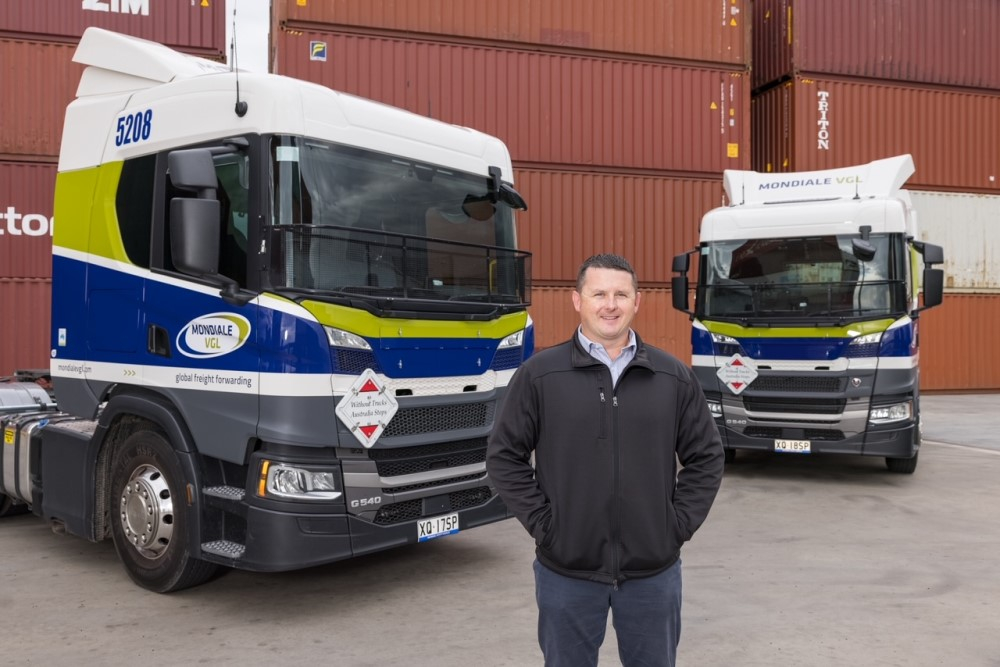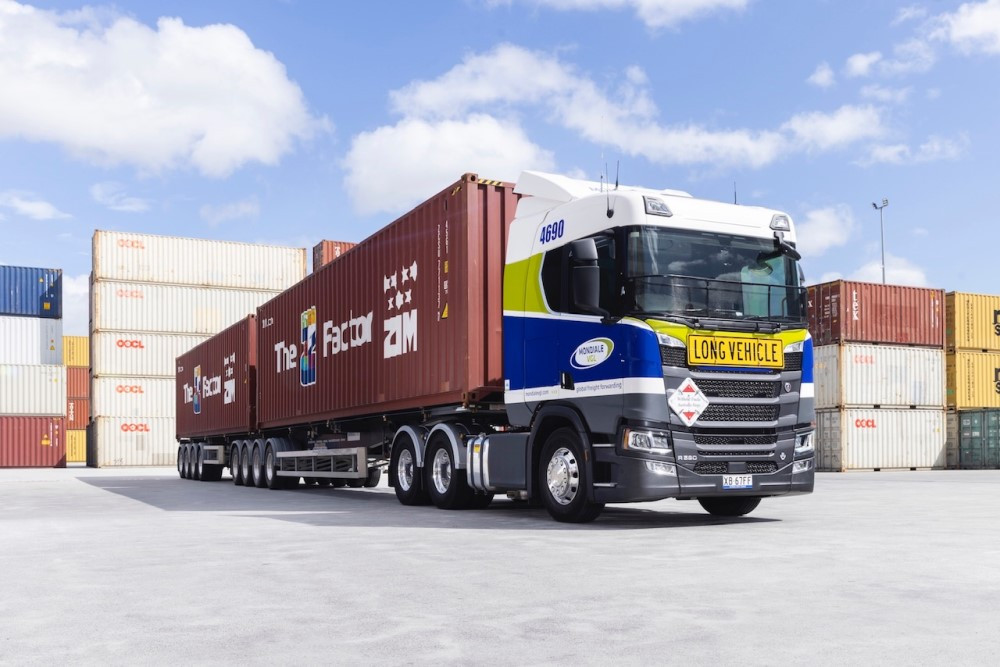
Giant Australian/NZ Logistics Group to go 100% Scania by 2024
MAJOR Oceania transport and logistics group Mondiale VGL has announced it will change its truck fleet entirely to Scania by early next year based on the truck-maker’s attractive service offerings, including its repair and maintenance contracts.
Mondiale VGL, which is a merger between Mondiale and Visa Global Logistics and traces its Australian and New Zealand origins back 40 years, is building to have a truck fleet of more than 130 prime movers by early 2024, many of them the latest Scania V8 and 6-cylinder ‘Super’ models.
The Super models were chosen for the greatest level of safety, fuel efficiency and reduced emissions available for heavy logistics work.
Mondiale VGL trucks work 24/6 so the choice for its fleet was based on uptime and predictable running costs, along with sophisticated vehicle monitoring data that allows flexible management of the on-road fleet.
Mondiale VGL national manager Fleet & Compliance, Rory Gerhardt, said the choice of Scania is providing long-term value to the company.
“The Scania product itself suits our business perfectly. By early 2024 we will have a 100 per cent operational Scania fleet, comprising around 130 prime movers,” he said.
“We work with Scania because of the quality of the equipment, the safety features, and the fact that we can access Euro-6 emission compliant engines.
“We believe we are the most modern waterfront transport company in Australasia, with the majority of our fleet being Euro-6. Scania has been a big advocate in relation to bringing Euro-6 to Australia.”
Mr Gerhardt said Mondiale VGL had “actively addressed our fuel burn” because almost half — historically — is consumed when idling, when waiting for loading at the wharf.
“Fuel and wages are the biggest costs to the business, so we have worked closely with Scania to address this, fitting auxiliary air conditioners — Scania calls them ‘cab coolers’ — that run on battery power so the trucks don’t need to idle their engines to keep drivers cool.
“The reduction in fuel burn is fantastic and the drivers appreciate this innovation.
“We have also fitted a non-overridable idle timer to ensure trucks don’t use fuel when stationary, so we’re not wasting fuel or generating needless emissions.”
He said that one of his company’s priorities was to reduce its carbon footprint.
“Scania’s fleet management portal has fleet performance data contained in the environmental reporting that is second to none,” he said.
“We get factual, actionable data in real time operating across our entire fleet in Australia and New Zealand. Now, I can sit in my office and see what our equipment is doing all around the country, and possibly in NZ as well.
“New tenders ask where we sit with CO2 emissions and what strategies we are deploying. We get the same requests from existing customers, who are also under the same constraints, particularly blue-chip companies.
“For our customers, transport is a large part of their business requirement, but they have no direct control, so when we can give them details of our carbon footprint and our fuel burn rate, that certainly makes it a lot easier for them to report our contribution to their environmental reduction rates.”

Mondiale VGL divers are equally as happy with the Scanias as the company.
“The functionality, comfort and drivability are key positives that we get as driver feedback,” he said.
“This is enhanced further after our drivers undergo the Scania Driver Training process.
“We have been putting drivers through this training over the past 12 months, so they have first-hand experience of the product, and the driver trainers are able to finesse their driving style to make the best possible use of the efficiency and safety systems on board. This is a boost to their sense of professionalism as well as making our fleet safer.”
In line with the drive towards higher productivity from company assets, Mondiale VGL has shifted to latest generation ‘high productivity vehicles’ (HPV) when shifting container traffic off the wharf to their customers or distribution centres.
“Our most important vehicles are the HPV and close to 90 per cent of our business is with HPVs. We’re running these as A-doubles and Super Sets, pulled by Scania 13-litre or 16-litre trucks. These are perfectly suited to the job,” Rory says.
“We have gone away from older model B-double and singles, switching to HPV and quad-axles. I have just ordered another batch of quads to suit our growing needs.
“Customers are now trying to put more and more into a container, so the ability to service those legally and safely, makes it (HPV) a more obvious equipment solution.
“The Scanias are plated and engineered for this, which again makes them perfect for our task.”
He said the company was involved in a lot of off-wharf cartage.
“We offer an end-to-end logistics product, controlling the product shipment from leaving the factory to being delivered to the customer in Australia, the whole way through,” he said.
“That’s our business model and we’re proud of what we do in that space.
“Off the wharf in Brisbane I have a Scania R 590 V8 rated at 110-tonne in a quad-quad setup that can pull two very heavy 40-ft containers or 4 x 20-ft containers. We also run 85-tonnes on the A-doubles, and up to 73-tonnes on the Super sets, all under PBS.
“This flexibility has helped us grow our business in Australia. We’re offering a flexible and seamless service, and for our customers that’s far more important that saving a few dollars on the delivery. Scania is helping us to achieve a top-class service,” he said.
Commercial vehicles are a serious investment, and getting truck finance right matters when your livelihood depends on keeping vehicles on the road. Credit One specializes in transport operators and understands what you're dealing with. As Australia's best-reviewed finance broker with 3,000+ Google reviews from operators nationwide, they've proven the approach works. Check out Credit One reviews to see for yourself, then use the loan repayment calculator to understand your options.